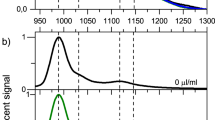Abstract
Carbon nanotubes can be thought of as graphitic sheets with a hexagonal lattice that have been wrapped up into a seamless cylinder. Since their discovery in 19911, the peculiar electronic properties of these structures have attracted much attention. Their electronic conductivity, for example, has been predicted2,3,4 to depend sensitively on tube diameter and wrapping angle (a measure of the helicity of the tube lattice), with only slight differences in these parameters causing a shift from a metallic to a semiconducting state. In other words, similarly shaped molecules consisting of only one element (carbon) may have very different electronic behaviour. Although the electronic properties of multi-walled and single-walled nanotubes5,6,7,8,9,10,11,12 have been probed experimentally, it has not yet been possible to relate these observations to the corresponding structure. Here we present the results of scanning tunnelling microscopy and spectroscopy on individual single-walled nanotubes from which atomically resolved images allow us to examine electronic properties as afunction of tube diameter and wrapping angle. We observe bothmetallic and semiconducting carbon nanotubes and find thatthe electronic properties indeed depend sensitively on thewrapping angle. The bandgaps of both tube types are consistent with theoretical predictions. We also observe van Hove singularities at the onset of one-dimensional energy bands, confirming the strongly one-dimensional nature of conduction within nanotubes.
This is a preview of subscription content, access via your institution
Access options
Subscribe to this journal
Receive 51 print issues and online access
$199.00 per year
only $3.90 per issue
Buy this article
- Purchase on Springer Link
- Instant access to full article PDF
Prices may be subject to local taxes which are calculated during checkout



Similar content being viewed by others
References
Iijima, S. Helical microtubules of graphitic carbon. Nature 354, 56–58 (1991).
Hamada, N., Sawada, S.-I. & Oshiyama, A. New one-dimensional conductors: graphite microtubules. Phys. Rev. Lett. 68, 1579–1581 (1992).
Saito, R., Fujita, M., Dresselhaus, G. & Dresselhaus, M. S. Electronic structure of chiral graphene tubules. Appl. Phys. Lett. 60, 2204–2206 (1992).
Mintmire, J. W., Dunlap, B. I. & White, C. T. Are fullerene tubules metallic? Phys. Rev. Lett. 68, 631–634 (1992).
Tans, S. J. et al. Individual single-wall carbon nanotubes as quantum wires. Nature 386, 474–477 (1997).
Bockrath, et al. Single-electron transport in ropes of carbon nanotubes. Science 275, 1922–1925 (1997).
Ebbesen, T. W. et al. Electrical conductivity of individual carbon nanotubes. Nature 382, 54–56 (1996).
Ge, M. & Sattler, K. Vapor-condensation generation of and STM analysis of fullerene tubes. Science 260, 515–518 (1993).
Zhang, Z. & Lieber, C. M. Nanotube structure and electronic properties probed by scanning tunneling microscopy. Appl. Phys. Lett. 62, 2792–2794 (1993).
Ge, M. & Sattler, K. STM of single-shell nanotubes of carbon. Appl. Phys. Lett. 65, 2284–2286 (1994).
Olk, C. H. & Heremans, J. P. Scanning tunneling spectroscopy of carbon nanotubes. J. Mater. Res. 9, 259–262 (1994).
Carroll, D. L. et al. Electronic structure and localized states at carbon nanotube tips. Phys. Rev. Lett. 78, 2811–2814 (1997).
Dresselhaus, M. S. Dresselhaus, G. & Eklund, P. C. Science of Fullerenes and Carbon Nanotubes (Academic, San Diego, (1996)).
Thess, A. et al. Crystalline ropes of metallic carbon nanotubes. Science 273, 483–487 (1996).
Cowley, J. M., Nikolaev, P., Thess, A. & Smalley, R. E. Electron nano-diffraction study of carbon single-walled nanotube ropes. Chem. Phys. Lett. 265, 379–384 (1997).
Venema, L. C. et al. STM atomic resolution images of single-wall carbon nanotubes. Appl. Phys. A(in the press).
Mintmire, J. W., Robertson, D. H. & White, C. T. Properties of fullerene nanotubules. J. Phys. Chem. Solids 54, 1835–1840 (1993).
White, C. T. et al. in Buckminsterfullerenes (eds Billups, W. E. & Ciufolini, M. A.) 125–184 (VCH, Weinheim, (1993)).
Kane, C. L. & Mele, E. J. Size, shape, and low energy electronic structure of carbon nanotubes. Phys. Rev. Lett. 78, 1932–1936 (1997).
Gadzuk, J. W. Resonance-tunneling spectroscopy of atoms adsorbed on metal surfaces: theory. Phys. Rev. B 1, 2110–2129 (1970).
Stroscio, J. A., Feenstra, R. M. & Fein, A. P. Electronic structure of the Si(111)2 × 1 surface by scanning tunneling spectroscopy. Phys. Rev. Lett. 57, 2579–2582 (1986).
Feenstra, R. M., Stroscio, J. A. & Fein, A. P. Tunneling spectroscopy of the Si(111)2 × 1 surface. Surf. Sci. 181, 295–306 (1987).
Lang, N. D. Spectroscopy of single atoms in the scanning tunneling microscope. Phys. Rev. B 34, R5947–R5950 (1986).
Hamers, R. J. in Scanning Tunneling Microscopy and Spectroscopy (ed. Bonnell, D. A.) 51–103 (VCH, New York, (1993)).
Wildöer, J. W. G., van Roij, A. J. A., van Kempen, H. & Harmans, C. J. P. M. Low-temperature scanning tunneling microscope for use on artificially fabricated nanostructures. Rev. Sci. Instrum. 65, 2849–2852 (1994).
Acknowledgements
The first two authors contributed equally to the present work. We thank S. J. Tans and J. C. Charlier for discussions, and L. P. Kouwenhoven, J. E. Mooij and P. M. Dewilde for support. The work at Delft was supported by the Dutch Foundation for Fundamental Research of Matter (FOM). The nanotube research at Rice was funded in part by the US NSF, the Texas Advanced Technology Program and the Robert A. Welch Foundation.
Author information
Authors and Affiliations
Corresponding author
Rights and permissions
About this article
Cite this article
Wilder, J., Venema, L., Rinzler, A. et al. Electronic structure of atomically resolved carbon nanotubes. Nature 391, 59–62 (1998). https://doi.org/10.1038/34139
Received:
Accepted:
Published:
Issue Date:
DOI: https://doi.org/10.1038/34139
This article is cited by
-
Transport through a correlated polar side-coupled quantum dot transistor in the presence of a magnetic field and dissipation
Scientific Reports (2024)
-
Potentialities of Bio-functionalized Carbon Nanotubes for Different Anti-cancerous Activities
Journal of Inorganic and Organometallic Polymers and Materials (2024)
-
Carbon nanotubes and nanobelts as potential materials for biosensor
Scientific Reports (2023)
-
Chirality-dependent electrical transport properties of carbon nanotubes obtained by experimental measurement
Nature Communications (2023)
-
Radial-tangential mode of single-wall carbon nanotubes manifested by Landau regulation: reinterpretation of low- and intermediate-frequency Raman signals
Scientific Reports (2023)
Comments
By submitting a comment you agree to abide by our Terms and Community Guidelines. If you find something abusive or that does not comply with our terms or guidelines please flag it as inappropriate.



